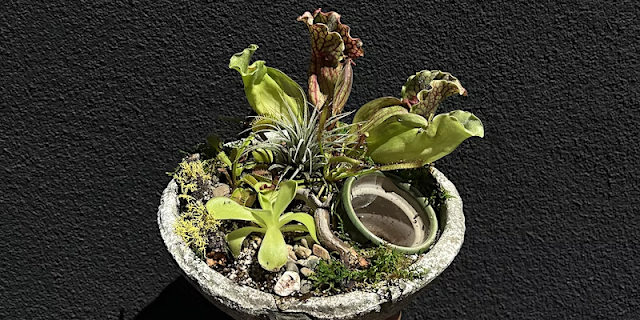
Exotic Plants hosts Saturday evening class featuring bug-eating beauties

|
|
The Exotic Plants bog bowl project features carnivorous plants. (Photo courtesy
Exotic Plants)
|
Looking for something totally different? This hands-on workshop focuses on the beauty of bug-eating plants.
Exotic Plants, Sacramento’s go-to indoor gardening store, is hosting a “Carnivorous Plant Arrangement Workshop,” featuring pitcher plants, Venus flytraps and other bug-munching flora.
Set for 6 p.m. Saturday, Aug. 27, the 90-minute workshop includes all the materials and plants needed for a living arrangement to take home. Price varies ($65 or $85) by choice of container; workshop participants can make a tabletop bog bowl or a mounted cork arrangement with pitcher plants to hang on a wall.
“The bog bowl class includes an American pitcher plant, Venus fly trap, butterwort and an octopus plant as well as all the materials you will need to create your own small carnivorous plant garden,” says the Exotic Plants crew.
“If that doesn’t pique your interest, there also is a Nepenthes mount class where we will show you how to mount your Nepenthes a.k.a tropical pitcher plant onto corkwood. We hope you'll join the fun, and will take a bite out of this fun class!”
Tickets are available via eventbrite.com at https://bit.ly/3R1Nder .
Exotic Plants is located at 1525 Fulton Ave., Sacramento. www.exoticplantsltd.com .
Comments
0 comments have been posted.Sacramento Digs Gardening to your inbox.
Sites We Like
Garden Checklist for week of April 21
This week there’s plenty to keep gardeners busy. With no rain in the immediate forecast, remember to irrigate any new transplants.
* Weed, weed, weed! Get them before they flower and go to seed.
* April is the last chance to plant citrus trees such as dwarf orange, lemon and kumquat. These trees also look good in landscaping and provide fresh fruit in winter.
* Smell orange blossoms? Feed citrus trees with a low dose of balanced fertilizer (such as 10-10-10) during bloom to help set fruit. Keep an eye out for ants.
* Apply slow-release fertilizer to the lawn.
* Thoroughly clean debris from the bottom of outdoor ponds or fountains.
* Spring brings a flush of rapid growth, and that means your garden is really hungry. Feed shrubs and trees with a slow-release fertilizer. Or mulch with a 1-inch layer of compost.
* Azaleas and camellias looking a little yellow? If leaves are turning yellow between the veins, give them a boost with chelated iron.
* Trim dead flowers but not leaves from spring-flowering bulbs such as daffodils and tulips. Those leaves gather energy to create next year's flowers. Also, give the bulbs a fertilizer boost after bloom.
* Pinch chrysanthemums back to 12 inches for fall flowers. Cut old stems to the ground.
* Mulch around plants to conserve moisture and control weeds.
* From seed, plant beans, beets, cantaloupes, carrots, corn, cucumbers, melons, radishes and squash.
* Plant onion sets.
* In the flower garden, plant seeds for asters, cosmos, celosia, marigolds, salvia, sunflowers and zinnias.
* Transplant petunias, zinnias, geraniums and other summer bloomers.
* Plant perennials and dahlia tubers for summer bloom.
* Mid to late April is about the last chance to plant summer bulbs, such as gladiolus and tuberous begonias.
* Transplant lettuce seedlings. Choose varieties that mature quickly such as loose leaf.